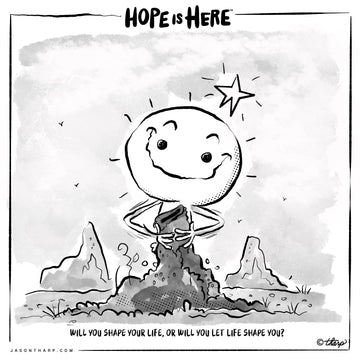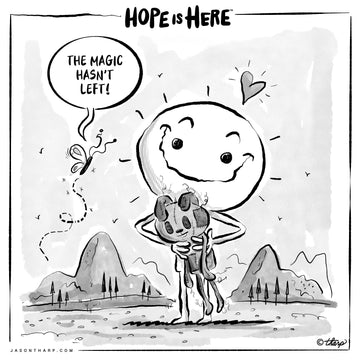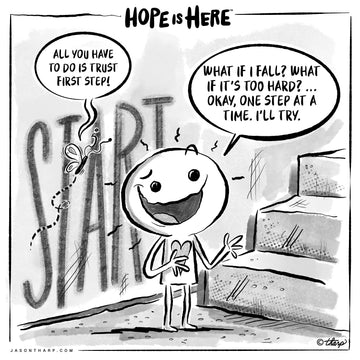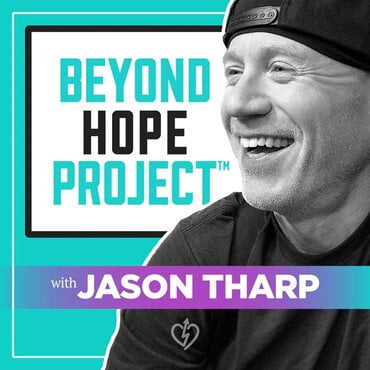We've all seen it. On t-shirts, coffee mugs, bumper stickers, and motivational posters plastered across social media feeds. "Keep Calm and Carry On." Most of us brush it off as another piece of fluffy inspiration, right up there with "Live, Laugh, Love" and "Good Vibes Only."
But what if I told you this simple phrase holds one of the most profound pieces of life advice you'll ever encounter?
The Real Story Behind the Famous WWII Slogan
This isn't just modern marketing fluff. The original "Keep Calm and Carry On" poster was created by the British government in 1939, designed to boost morale during World War II. It was meant to be distributed if Germany invaded Britain. The message wasn't about toxic positivity or pretending everything was fine. It was about maintaining composure and continuing forward movement in the face of genuine crisis.
The British understood something we've forgotten: our emotions are the gatekeepers to this moment, which, by the way, is the only thing real in this world.
Why Our Emotions Hijack Our Present Moment
Think about it for a minute. How often do we let our moments slip by us unnoticed simply because our emotions get the best of us?
The Science of Mind Wandering
Research from Harvard psychologist Dr. Matthew Killingsworth found that the average person's mind wanders 47% of the time. Nearly half our lives are spent somewhere other than the present moment. We're either replaying yesterday's mistakes or rehearsing tomorrow's worries, missing the only moment where life actually happens.
Understanding Emotional Hijacking
And don't beat yourself up over this. We all slip on this. Studies show that our brains process emotions 20 times faster than rational thought. When something triggers us, our amygdala fires before our prefrontal cortex even knows what hit us. We're literally hijacked by our own emotional responses.
What's important, though, is raising our awareness to this slip so we can quickly get ourselves back to reality rather than just letting it slip into the pile of "Holy cow! Where did the day go?" Because let's face it, that's its own mountain as well.
Navigating Life's Emotional Whitewater Rapids
Our key to navigating life is to not get swept up in the whitewater rapids of our emotions. We need to get our life vest on as fast as possible before helping others.
We hear that every time we take off in a plane, and it's often ignored, but what great advice: secure your own oxygen mask first. Get to know where you are before moving forward with helping the greater whole.
A Brain Cancer Survivor's Lesson in Emotional Resilience
Perhaps this is why it took me so long to share my story? When you're given seven months to live with Grade 4 Glioblastoma, every emotion hits like a tsunami. Fear, anger, grief, hope, despair. They all crash over you in waves, and your first instinct is to help everyone else process what's happening to you.
But I learned something profound during that journey.
The Life-Changing Power of the Pause
I discovered that the more I took time to ask myself questions and, most importantly, PAUSE and wait for the answer, not only was I better off, but those around me were as well. It became the most transformative thing for my healing and evolution as a human.
The 90-Second Rule for Emotional Regulation
Neuroscientist Dr. Jill Bolte Taylor discovered that emotions have a 90-second chemical lifespan in our bodies. Ninety seconds. That's it. If we can ride out that initial wave without getting swept away by the story our mind creates around it, the emotion naturally dissipates.
The problem isn't the emotion itself. It's our resistance to it, our judgment of it, and our tendency to create elaborate narratives around it that keep us trapped in emotional quicksand.
Your Breath: The Ultimate Mindfulness Reset Button
So rather than beat yourself up if you find yourself lost in the emotions of it all, pause. Take a breath. Be aware of the breath.
This, after all, is the disruption to all the overthinking you're doing.
How Breathing Techniques Anchor You to Reality
Your breath is your anchor to reality. When your mind is spinning stories about what might happen or what should have happened, your breath is happening right now. It's the most honest thing about you in any given moment.
Paying attention to your breath teleports you back to reality and this moment, where you can plug into what's actually happening versus staying plugged into a world full of assumptions and predictions.
Keep Calm: The H.O.P.E. Algorithm Connection
This is where "Keep Calm and Carry On" becomes more than a slogan. It becomes a strategy.
Keep Calm is about becoming Hyper-Aware of your emotional state without being controlled by it. It's about staying Open-Hearted to what you're feeling without drowning in it.
Carry On is about being Persistent in your forward movement, even when your emotions are screaming at you to stop. It's about Empowering yourself to choose your response rather than being a victim of your reactions.
The British didn't create this message to encourage people to suppress their emotions during wartime. They created it to remind people that they had a choice in how they responded to circumstances beyond their control.
Your Starting Line for Emotional Mastery Is Here
You're not broken for feeling overwhelmed. You're not weak for getting swept up in emotional rapids. You're human.
But you're also powerful. You have the ability to pause, breathe, and choose your next move from a place of awareness rather than reaction.
The next time life feels like it's spinning out of control, remember: your emotions are information, not instructions. They're telling you something important about your experience, but they don't get to drive the car.
Keep calm. Carry on. And remember that hope isn't a passive wish—it's a strategy.
Your strategy starts with your next breath.









